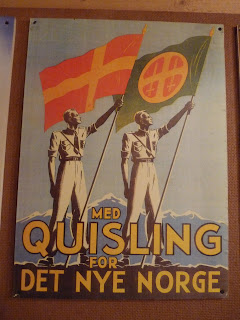As I sit here gazing at the glassy-calm sea, knowing that Scotland lies somewhere beyond the horizon, the view is as peaceful as could be. It is almost impossible to imagine such a place could ever have been otherwise. But right here, on the Norwegian coast seven decades ago, there would have been a line of young German soldiers stationed at their gun-emplacements and look-out posts, keeping watch for us, their enemy. If the concrete debris they left behind were ever removed, you might never believe what history tells us.
Exactly 70 years ago, on 9th April 1940, a scattering of little dots was spotted in the sky above Sola Airport near Stavanger. Ever so slowly the dots grew larger as they floated gently towards the ground. It was one of several shocks Norway was to face that day, and one of the biggest shocks in the nation’s history.
The little dots turned out to be German troops sent to capture the airfield, the start of the German Occupation of Norway. Within minutes, two infantry battalions had landed along with regimental staff. Once onto terra firma, they gathered up their equipment and started marching the 15 kilometres or so into Stavanger itself. They secured the city’s port, thus ensuring the safe arrival of reinforcements, heavy weapons and supplies being delivered by German ships that had been lurking offshore.
The subjugation of Norway had not originally been part of Hitler’s plans for taking over Europe. However, Grossadmiral Erich Raeder, Commander-in-Chief of the Kreigsmarine, believed that securing Norway’s ports would strengthen Germany’s operational basis against its main enemy, the British Royal Navy. He mentioned his thoughts to Hitler.
Raeder was encouraged by the man who has given his name to the dictionary, Vidkun Quisling. (A ‘quisling’ is defined as ‘one who aids the enemy’.) Following a coup, former Norwegian Foreign Minister Quisling had proclaimed himself Prime Minister and Hitler had decided to support him. Quisling and his Norwegian Fascist Party had requested support from the German army in an attempt at a peaceful occupation. While this came to nothing, on his visit to Berlin in December 1939 Quisling had met Raeder and had mentioned the Norwegian Government’s intention not to resist any Allied landings. Three days later, Hitler had ordered that the plans to seize Norway be examined.
Not only did Hitler think a British occupation of Norwegian ports would be disastrous, but he was concerned about shipments of Swedish iron ore sailing out of the northerly town of Narvik, shipments that were essential to the Nazi war machine. If the Allies occupied Narvik, these shipments would cease. Operation Weserubung was set in motion, which came to represent the first joint air-land-sea campaign in the history of warfare.
Thus on 9th April 1940 German naval units, infantry divisions and Luftwaffe squadrons began their invasion of both Denmark and Norway. Denmark capitulated that morning. Not so Norway. In addition to occupying Stavanger, the German forces secured Oslo, and the ports of Kristiansand, Bergen, Trondheim and Narvik.
The Germans had every reason to be satisfied with their attack on Norway, having met with little resistance. They could now enjoy superior fire power of automatic weapons, tanks, and artillery easily capable of smashing any resistance. Despite this German superiority, having been forced to take sides, Norway had already decided to back Great Britain. Now Norway must place her faith in the Allies, who had promised to come to the rescue.
There followed five long years of occupation, during which many heroic acts of resistance were carried out by Norwegians. It was a terrifying time, and I’ve been told it is not possible to explain the feeling induced by enemy occupation unless one has experienced it. It does not do justice to some of these stories to include them too briefly, so I will come back to them. But the tales I have heard are remarkable, of ordinary families who had to put up with enemy troops taking over their property, stomping through their houses in their big boots, living in people’s homes, often alongside the owners, destroying anything that could be conceived as being helpful to the resistance, and all with the threat of being shot if you stepped out of line.
As a nation which had only won true independence a few decades earlier after centuries of Danish and then Swedish domination, this German occupation was a bitter pill, not to mention a terrifying one. Scotland and Britain as a whole played a significant part in the resistance, and the stories are still being told today of how our two nations worked together. But it was a unique period which left an indelible mark upon the Norwegian nation. It is no surprise that Norway is now well-known as a nation that continues to play an important role in the pursuit of world peace.
Dear scribbles...
-
Thank you for your emails and my apologies if the Great Silence has worried
anyone. This is to reassure you you that we are absolutely fine and well
and ha...





Spot on, very good article. The memory of April 9th 1940 is so vividly present in this country that my nine year old Norwegian born and bred son only remembers my birthday because it coincides with the date of the German invasion...
ReplyDeleteFollow up on recent question of a few minutes ago. Not a viking ship. More like rowboat.
ReplyDelete